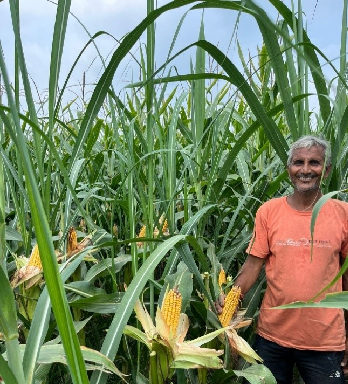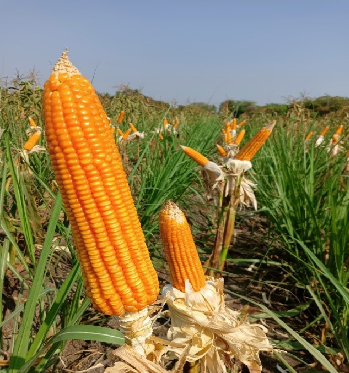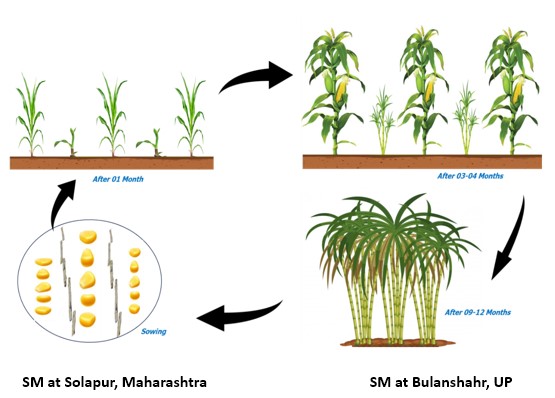Sugarcane (Saccharum officinarum L.) is one of India’s most important commercial crops, grown across 5.4 million hectares, with Uttar Pradesh, Maharashtra, Karnataka, and Tamil Nadu leading in production. Traditionally cultivated as a monocrop, sugarcane provides income to farmers only once a year after a long growing period of 10–15 months. During this time, farmers often depend on middlemen or moneylenders to meet household expenses. At the same time, sugar mills operate only for 3–5 months annually, restricting ethanol production to a limited window, even though sugarcane currently meets 30–35% of India’s ethanol requirement.

To address this gap, the ICAR–Indian Institute of Maize Research, Ludhiana, developed an innovative Sugarcane + Maize (SM) intercropping system under the flagship project “Enhancement of Maize Production in the Catchment Area of Ethanol Industries” supported by the Ministry of Agriculture and Farmers’ Welfare, Government of India. The approach was designed to accelerate land productivity, ensure round-the-year feedstock supply for dual-feed ethanol distilleries, and enhance farmer incomes.
Historically, sugarcane intercropping was limited to vegetables like onion and garlic, but pest issues and management challenges restricted adoption. Maize emerged as the ideal partner crop for sugarcane, owing to its shorter duration, better adaptability, and compatibility with sugarcane’s agronomic practices. In pilots across Maharashtra, Haryana, and Uttar Pradesh, ICAR-IIMR scientists leveraged sugarcane’s slow initial growth phase to introduce short-duration maize hybrids (~100 days), making it possible to grow two crops simultaneously using nearly the same resources water, fertilizers, herbicides, and pesticides.

A 50-acre pilot in Solapur (Maharashtra) and Bulandshahr (Uttar Pradesh) showcased the potential of this model. By fine-tuning crop management such as maintaining 33–50% maize plant density, applying an additional top-dressing of urea, and detopping maize at the brown husk stage the system significantly boosted productivity. Detopping not only improved sunlight penetration for sugarcane but also provided nutritious green fodder, while enabling in-situ cob drying for higher-quality maize grain.
The results were transformative. Farmers recorded a 28% increase in sugarcane equivalent yield, along with an additional 3.5–5 tonnes/ha of maize. Net returns rose by ₹50,000–1,00,000 per hectare, with the cost of maize cultivation reduced by nearly 75% compared to sole maize farming. Beyond profits, the system delivered broader sustainability benefits optimized resource use, reduced input costs, improved soil health, and assured year-round maize supply to dual-feed ethanol plants.

The scalability of the SM model is immense. With 50% of the planted cane area (~15 lakh hectares) amenable to adoption, the system could potentially generate 40–60 lakh tonnes of maize annually, ensuring reliable feedstock for nearly 500 sugarcane-based ethanol distilleries in the country. Demonstrations in Solapur have already inspired farmers, who report quicker cash flow, lower risks, and enhanced profitability.

This farmer-centric innovation reflects the power of science-led solutions in driving sustainable intensification and energy security. By integrating sugarcane with maize, ICAR–IIMR has laid the foundation for a win–win model that strengthens farm incomes, supports the ethanol blending programme, and contributes to both feed and energy security.
Video Link: https://youtu.be/TdmbE1C8AIk?si=JzNVwDt1O2rNWYXa
(Source: ICAR-Indian Institute of Maize Research, Ludhiana)








Like on Facebook
Subscribe on Youtube
Follow on X X
Like on instagram